Blackwork: a bit of history
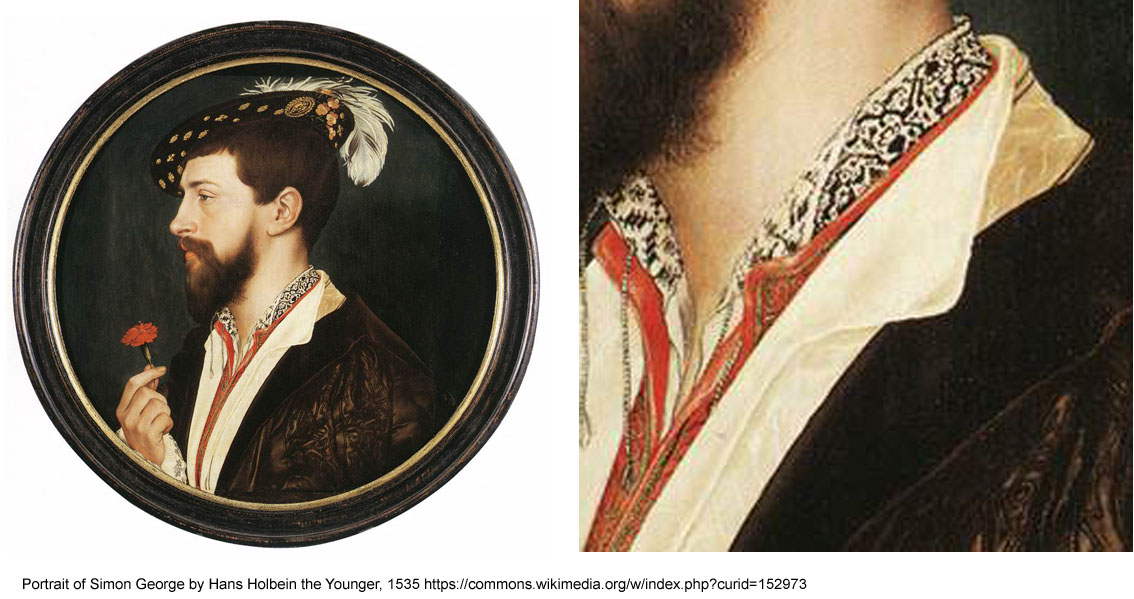 Blackwork is a wonderful technique that lets you create lace-like patterns applied on fabric. It became popular in 16th century England when King Henry VIII married Catherine of Aragon who brought with her new fashion styles from the court of Spain. The motifs were used mostly on collars and cuffs. The embroidery technique became quite popular and known as Spanish work. When eventually the king divorced his wife, it remained popular but was renamed Blackwork.
Blackwork is a wonderful technique that lets you create lace-like patterns applied on fabric. It became popular in 16th century England when King Henry VIII married Catherine of Aragon who brought with her new fashion styles from the court of Spain. The motifs were used mostly on collars and cuffs. The embroidery technique became quite popular and known as Spanish work. When eventually the king divorced his wife, it remained popular but was renamed Blackwork.
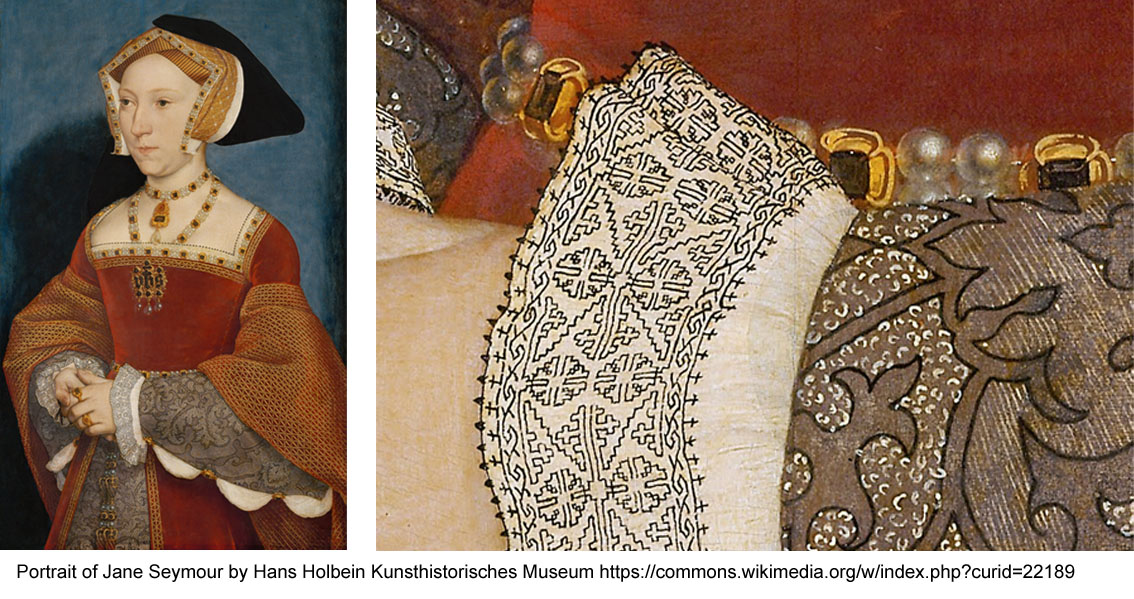
Notice the wonderfully detailed portraits, both by Hans Holbein. Left: Jane Seymour, third wife of King Henry VIII. The painting is so detailed, it could actually be reproduced in stitching.
Source & Photo credit: Wikipedia
Above is a portrait of Simon George: Notice the open collar and the reversible stitching.
Source & Photo credit: Wikipedia
>> more information on the origin of Blackwork (Wikipedia)
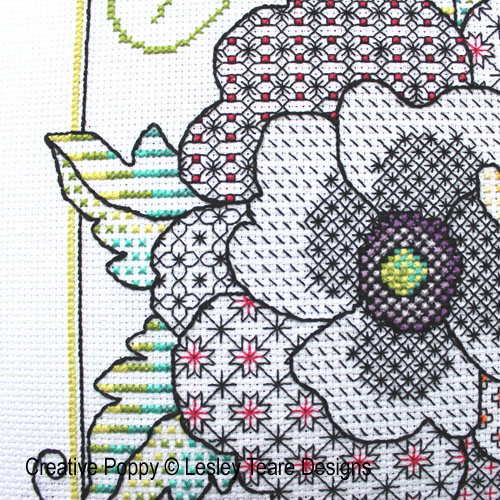
Modern Blackwork
First and foremost, Blackwork is no longer Black. It can be red, it can be multicolor, it can be black with subtle addition of color, it can be anything. It is a lot of fun.
Blackwork now takes many forms and styles. The beauty of blackwork is that, like cross stitch, it is a counted technique that can be charted on a grid. This means it can be reproduced without fail, provided one follows the chart, using the weft and warp of the fabric as a fool proof guide.
Some Blackwork designs use delineating areas, like compartments, filling them with repeated motifs. Each motif generates a different shade, depending on the density of the stitching.
Other blackwork designs can take a much freer approach, with figurative motifs and soft curves. Sometimes, when blackwork is blended with some cross stitch, it’s difficult to really draw the line between the two.
A question of stitches: stitching continuous lines
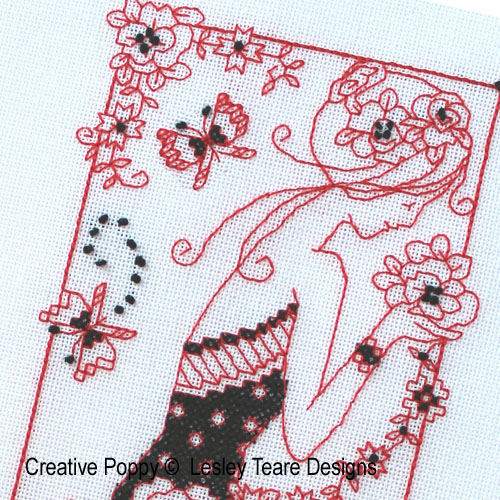 Backstitch is the default stitch for most contemporary designs. It is the stitch recommended by Lesley Teare for all her Blackwork designs.
Backstitch is the default stitch for most contemporary designs. It is the stitch recommended by Lesley Teare for all her Blackwork designs.
There are cases however where a stitcher will have to make her own decisions, which pathway to follow and which stitch to use. We would like to take the opportunity to discuss various options available to stitchers when encountering a continuous line on a chart:
- Long stitch
- Backstitch
- Double running stitch or Holbein stitch
- Hybrid backstitch
Long stitch:
Long stitch is when you make a long line in a single stitch. Except if the design specifically calls for it, it is usually used in very specific cases, for example when you want to emphasize that the line is string like. For example the line on a fishing rod, or a spider web. It's best used in a single strand so the line looks sharper.
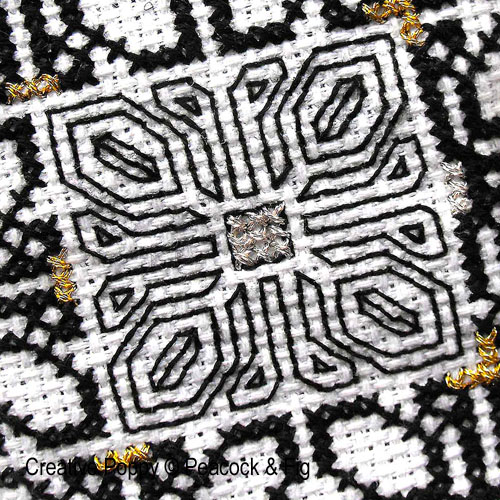 Backstitch:
Backstitch:
Backstitch is often the default stitch used for Blackwork. Cross stitchers will be familiar with backstitch, which is abundantly used in cross stitch.
Backstitch is ideal for complex lines and motifs. You can progress with backstitch in a line, starting at one end and finishing at the other, following any “buckles” you find on your way, like a piece of string. When you follow a “branch” like motif however, you may end up in many dead ends that require stopping your thread and starting again from another point. The alternative is “skipping” from a spot to another, which is not usually recommended because of the risk of those lines showing through the fabric.
An other specificity of backstitch, is that it creates a rather bulky line on the back of the stitching. It actually doubles up the number of stitches on the wrong side of the fabric. This is not usually a problem, except if you are working in dense areas, in which case it’s helpful to keep the back as nice and neat as possible to avoid embroidery threads becoming entangled.
Double running stitch or Holbein sitch:
Double running stitch is an alternative to Backstitch. It’s also called Holbein stitch because of the way the painter (see above) depicted Blackwork fashion in exquisite detail. At the time, Blackwork was worked in double running stitch. This had the great advantage of being reversible – the pattern is exactly the same on both sides of the fabric.
Double running stitch starts and ends at the same point. It’s therefore often described as two journeys, onward and return, with a turning point when you reach the end of the line. Basically it means skipping every second stitch along the line, leaving them ready for retracing your way back. In comparison, Backstitch starts at one end, and finishes at the other.
You can use Double running stitch for frames, for zigzag patterns, for simple and repetitive motifs. Double running stitch can also be used when the lines branch off, either in loops (leafs or petals) or dead ends (branch ends). See diagram below.
All you need to do is branch off on a side journey, which you will complete as you return. See below how you branch out on the left as you reach the first leaf, still only completing every second stitch, then continue along the stem, branch off on a second side journey for the second pair of leaves and finally reach the end. Retace your steps filling all the blanks, including side trips until you reach your starting point.
The advantage of running stitch is that it will always leave a clean and single line on the reverse. It is however more complex to use than backstitch as you have to anticipate the pathway you intend to take. It requires more concentration than backstitch as you can only see one half of the motif and you can easily get "lost" if the design is complex.
Hybrid Backstitch:
For want of a better term, we have called this stitch, which is a mix of backstitch and running stitch, the Hybrid backstitch. There might be another specific term but we are not aware of it.
The principle of the hybrid backstitch is that you basically work a running stitch, returning backwards every second stitch to fill the blank. This stitch uses much less thread than backstitch, or even double running stitch, as you can see in the diagram below (stitches on the back of the fabric are shown in grey).
Dana Batho, Peacock & Fig's designer, likes to use this stitch when working a backstitch.
You can view a video here where she shows how to work the stitch.
>> Peacock & Fig: Backstitch tutorial
The main advantage of the hybrid backstitch, apart from using much less thread, is that it keeps the back of the fabric nice and clean. There are fewer of the diagonal lines cutting corners that you encounter in backstitch. Its also easy to use, once you get accustomed to it.
We hope you enjoyed this discussion. If you have any comments or suggestions, please feel very welcome to contact us.
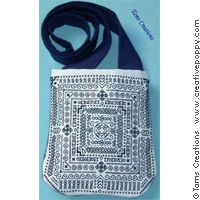
A selection of Blackwork designs
Creative Poppy is proud to carry a beautiful selection of Blackwork designs, in particular those of Lesley Teare and Tam's creations who carry a large selection. Many other of our designers also offer some interesting Blackwork patterns, check them out too!
>> Blackwork patterns by Lesley Teare
>> Blackwork patterns by Tam's Creations
>> all Blackwork patterns (all designers)
>> back to latest news